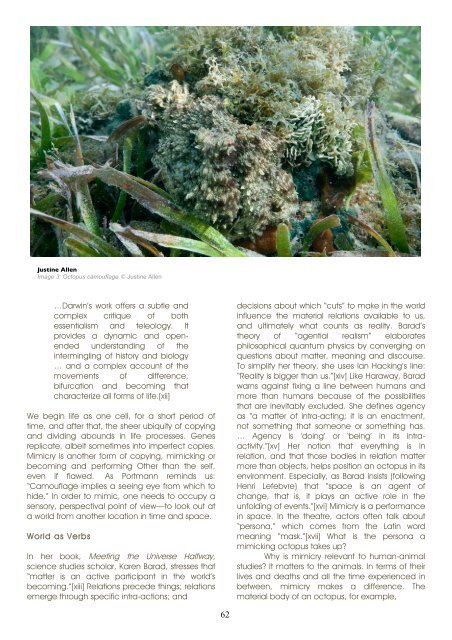Animal Influence I - Antennae The Journal of Nature in Visual Culture
Animal Influence I - Antennae The Journal of Nature in Visual Culture
Animal Influence I - Antennae The Journal of Nature in Visual Culture
You also want an ePaper? Increase the reach of your titles
YUMPU automatically turns print PDFs into web optimized ePapers that Google loves.
Just<strong>in</strong>e Allen<br />
Image 3: Octopus camouflage Just<strong>in</strong>e Allen<br />
…Darw<strong>in</strong>’s work <strong>of</strong>fers a subtle and<br />
complex critique <strong>of</strong> both<br />
essentialism and teleology. It<br />
provides a dynamic and openended<br />
understand<strong>in</strong>g <strong>of</strong> the<br />
<strong>in</strong>term<strong>in</strong>gl<strong>in</strong>g <strong>of</strong> history and biology<br />
… and a complex account <strong>of</strong> the<br />
movements <strong>of</strong> difference,<br />
bifurcation and becom<strong>in</strong>g that<br />
characterize all forms <strong>of</strong> life.[xii]<br />
We beg<strong>in</strong> life as one cell, for a short period <strong>of</strong><br />
time, and after that, the sheer ubiquity <strong>of</strong> copy<strong>in</strong>g<br />
and divid<strong>in</strong>g abounds <strong>in</strong> life processes. Genes<br />
replicate, albeit sometimes <strong>in</strong>to imperfect copies.<br />
Mimicry is another form <strong>of</strong> copy<strong>in</strong>g, mimick<strong>in</strong>g or<br />
becom<strong>in</strong>g and perform<strong>in</strong>g Other than the self,<br />
even if flawed. As Portmann rem<strong>in</strong>ds us:<br />
“Camouflage implies a see<strong>in</strong>g eye from which to<br />
hide.” In order to mimic, one needs to occupy a<br />
sensory, perspectival po<strong>in</strong>t <strong>of</strong> view—to look out at<br />
a world from another location <strong>in</strong> time and space.<br />
World as Verbs<br />
In her book, Meet<strong>in</strong>g the Universe Halfway,<br />
science studies scholar, Karen Barad, stresses that<br />
“matter is an active participant <strong>in</strong> the world’s<br />
becom<strong>in</strong>g.”[xiii] Relations precede th<strong>in</strong>gs; relations<br />
emerge through specific <strong>in</strong>tra-actions; and<br />
62<br />
decisions about which “cuts” to make <strong>in</strong> the world<br />
<strong>in</strong>fluence the material relations available to us,<br />
and ultimately what counts as reality. Barad’s<br />
theory <strong>of</strong> “agential realism” elaborates<br />
philosophical quantum physics by converg<strong>in</strong>g on<br />
questions about matter, mean<strong>in</strong>g and discourse.<br />
To simplify her theory, she uses Ian Hack<strong>in</strong>g’s l<strong>in</strong>e:<br />
“Reality is bigger than us.”[xiv] Like Haraway, Barad<br />
warns aga<strong>in</strong>st fix<strong>in</strong>g a l<strong>in</strong>e between humans and<br />
more than humans because <strong>of</strong> the possibilities<br />
that are <strong>in</strong>evitably excluded. She def<strong>in</strong>es agency<br />
as “a matter <strong>of</strong> <strong>in</strong>tra-act<strong>in</strong>g; it is an enactment,<br />
not someth<strong>in</strong>g that someone or someth<strong>in</strong>g has.<br />
… Agency is ‘do<strong>in</strong>g’ or ‘be<strong>in</strong>g’ <strong>in</strong> its <strong>in</strong>traactivity.”[xv]<br />
Her notion that everyth<strong>in</strong>g is <strong>in</strong><br />
relation, and that those bodies <strong>in</strong> relation matter<br />
more than objects, helps position an octopus <strong>in</strong> its<br />
environment. Especially, as Barad <strong>in</strong>sists (follow<strong>in</strong>g<br />
Henri Lefebvre) that “space is an agent <strong>of</strong><br />
change, that is, it plays an active role <strong>in</strong> the<br />
unfold<strong>in</strong>g <strong>of</strong> events.”[xvi] Mimicry is a performance<br />
<strong>in</strong> space. In the theatre, actors <strong>of</strong>ten talk about<br />
“persona,” which comes from the Lat<strong>in</strong> word<br />
mean<strong>in</strong>g “mask.”[xvii] What is the persona a<br />
mimick<strong>in</strong>g octopus takes up?<br />
Why is mimicry relevant to human-animal<br />
studies? It matters to the animals. In terms <strong>of</strong> their<br />
lives and deaths and all the time experienced <strong>in</strong><br />
between, mimicry makes a difference. <strong>The</strong><br />
material body <strong>of</strong> an octopus, for example,












